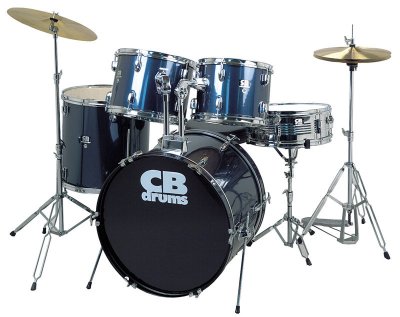Introduction
The drum kit is my favorite musical instrument, so I chosen that theme for my article
 |
| Drum |
Drums consist of at least one membrane, called a drumhead or drum skin, that is stretched over a shell and struck, either directly with the player's hands, or with a drumstick, to produce sound. There is usually a "resonance head" on the underside of the drum, these are usually tuned to a slightly lower pitch than the top drumhead. Drums are usually played by the hand, or by one or two sticks. In many traditional cultures drums have a symbolic function and are often used in religious ceremonies.
The union of drums and cymbals makes a drum kit
A drum kit is a collection of drums, cymbals and often other percussion instruments, such as cowbells, wood blocks, triangles, chimes, or tambourines, arranged for convenient playing by a single person (drummer).
Drum Kit
 |
| Drum kit |
The individual instruments of a drum kit are hit by a variety of implements held in the hand, including sticks, brushes, and mallets. Two exceptions include the bass drum, played by a foot-operated pedal, and the hi-hat cymbals, which may be struck together using a foot pedal in addition to being played with sticks or brushes. Although other instruments can be played using a pedal, the feet are usually occupied by the bass drum and hi hat, and as a result the drummer often plays in a seated position. Percussion notation is often used by drummers to signify which drum kit components are to be played. A full size drum kit without any additional percussion instruments includes a bass drum, floor tom, snare drum, tom-toms, and a variety of cymbals including hi-hat cymbals, a ride cymbal and one or more crash cymbals. The exact set-up is dictated by the type of music played and the drummer's personal preferences. For example, in most forms of rock music, the bass drum, hi-hat and snare drum are the primary instruments used to create a drum beat, whereas in jazz, ride and snare patterns tend to be more prevalent and the hi-hat is played with the foot.
The exact collection of a drum kit's components depends on factors such as musical style, personal preference, and transportation options of the drummer. Cymbal, hi-hat, and tom-tom stands, as well as bass drum pedals and drum thrones are usually standard in most drum kits. Most mass produced drum kits are sold in one of two five-piece configurations (referring to the number of drums only), which typically include a bass drum, a snare drum, two toms, and one floor tom.
The standard hardware pack includes a hi-hat stand, a snare drum stand, two or three cymbal stands, and a bass drum pedal. Drum kits are usually offered as either complete kits which include drums and hardware, or as “shell packs” which include only the drums and sometimes tom mounting hardware. Cymbals are usually purchased separately and are also available in either packs or as individual pieces.
-
- Five-piece

- Bass drum & pedal(s)
- Snare drum
- Floor tom
- Mounted tom (with mounting hardware) or second floor tom
- Mounted tom (with mounting hardware)
- Hi-hat cymbals & stand
- Cymbal & stand
- Ride cymbal & stand
- Throne
-
Electronic drums

Some drummers use some or all electronic drum components. There are two approaches to using electronic drums. One approach is to use drum trigger pads for all of the different instruments. These pads are discs with a rubber-type coating that can be mounted on stands in the same locations that the traditional drum shells would be placed. Each disc has a piezoelectric transducer which transmits an electronic signal when it is struck. A patch cord from each drum pad disc is plugged into a drum synthesizer module and connected to the appropriate synthesized or sampled drum sound. Thus, when the drummer strikes the drum pad that is designated as the snare drum pad, the synthesizer module produces the sound of a snare drum. Since the sound is produced by a synthesizer, a performer can choose a range of sounds, such as samples of an actual drum or cymbal or electronic drum sounds. A drummer could even have the synthesizer produce non-drum sounds, such as sound effects or pitched notes
The advantage of playing with a purely electronic drum kit is that there is no live drum sound, apart from any sound from a monitor or keyboard amplifier (which can be easily turned up or down).
Another approach to making electronic drums is to use an acoustic drum kit (wooden shells and metal cymbals) and attach trigger sensors to each drum or cymbal. The sensors are then routed to a synthesizer module in the same fashion as a purely electronic drum kit. The advantage of this approach is that a drummer could switch between traditional, natural drum sounds and electronica drum sounds throughout a performance.
Drummer
A drummer is a musician who is capable of playing drums, which includes but is not limited to a drum kit and accessory based hardware which includes an assortment of pedals and standing support mechanisms, marching percussion and/or any musical instrument that is struck within the context of a wide assortment of musical genres.
The term percussionist applies to a musician who performs struck musical instruments of numerous diverse shapes, sizes and applications.
Conclusions
- The drum kit is a collection of drums that are played by a single person
- The technology made an electronic drum that substituted the big wood instrument
References
Drum - Wikipedia, the free encyclopedia
Drum kit - Wikipedia, the free encyclopedia
Drummer - Wikipedia, the free encyclopedia

